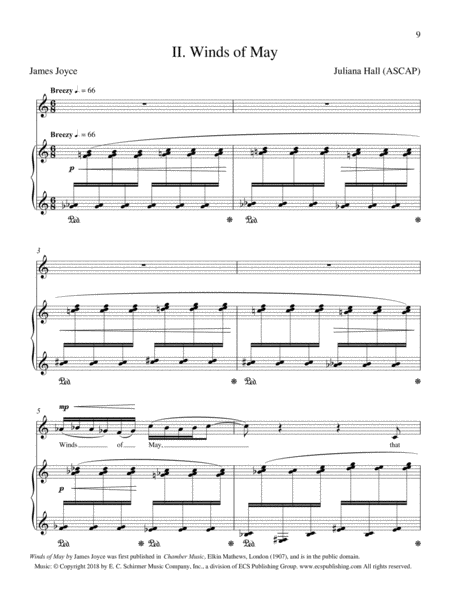Contralto voice and piano - Medium - Digital Download SKU: MQ.8769-2E Composed by Juliana Hall. 7 pages. E. C. Schirmer Music Company - Digital #8769-2E. Published by E. C. Schirmer Music Company - Digital (MQ.8769-2E). English.Juliana Hall wrote her song cycle Of That So Sweet Imprisonment for mezzo soprano Stephanie Blythe, for whom Hall had expressed a desire to write a piece. Blythe accepted Hall's proposal, and her request was that Hall write a song cycle for contralto voice. In recounting her motivation for writing this piece, Hall - in a discussion with Blythe at the Fall Island Vocal Arts Seminar (where Hall was the Guest Composer in 2018) - said You know what I think is really so wonderful is how you [Blythe] communicate, from here to there, right to the audience...it just speaks, the words, the text, come right...right to the heart of each person...I was thinking, what a wonderful person, what a wonderful voice...to be able to communicate...I've just got the most perfect singer to take these songs, this wonderful subject of love, and present it to the worldThe seven poems Hall set in Of That So Sweet Imprisonment were chosen from James Joyce's early book of poems, Chamber Music (Elkin Mathews, London) published in 1907. The poems are arranged in a narrative arc that takes the listener from the presence of love in nature (Strings in the Earth and Air), to the human feeling of emptiness when love is not present (Winds of May), to a description exulting in the joys of human love (Of That So Sweet Imprisonment), to expression of human love such as kissing (In the Dark Pine-Wood), to love's tranformation of a girl into a woman through love making (Bid Adieu), to the feelings of contentment in the early morning after making love (At That Hour When All Things Have Repose), and finally a call for the lovers to go to a special place where they may remain together in love (O Cool is the Valley).Of That So Sweet Imprisonment will be premiered on Saturday, January 19, 2019 at the DiMenna Center for Classical Music in New York City, by Ms. Blythe and pianist Alan Smith, on the third concert of the Sparks & Wiry Cries' NYC songSLAM Festival, entitled Expressions of Love: Stephanie Blythe and Friends.Contents:I. Strings in the Earth and AirII. Winds of MayIII. Of That So Sweet ImprisonmentIV. In the Dark Pine-WoodV. Bid AdieuVI. At That Hour When All Things Have ReposeVII. O Cool is the Valley.
